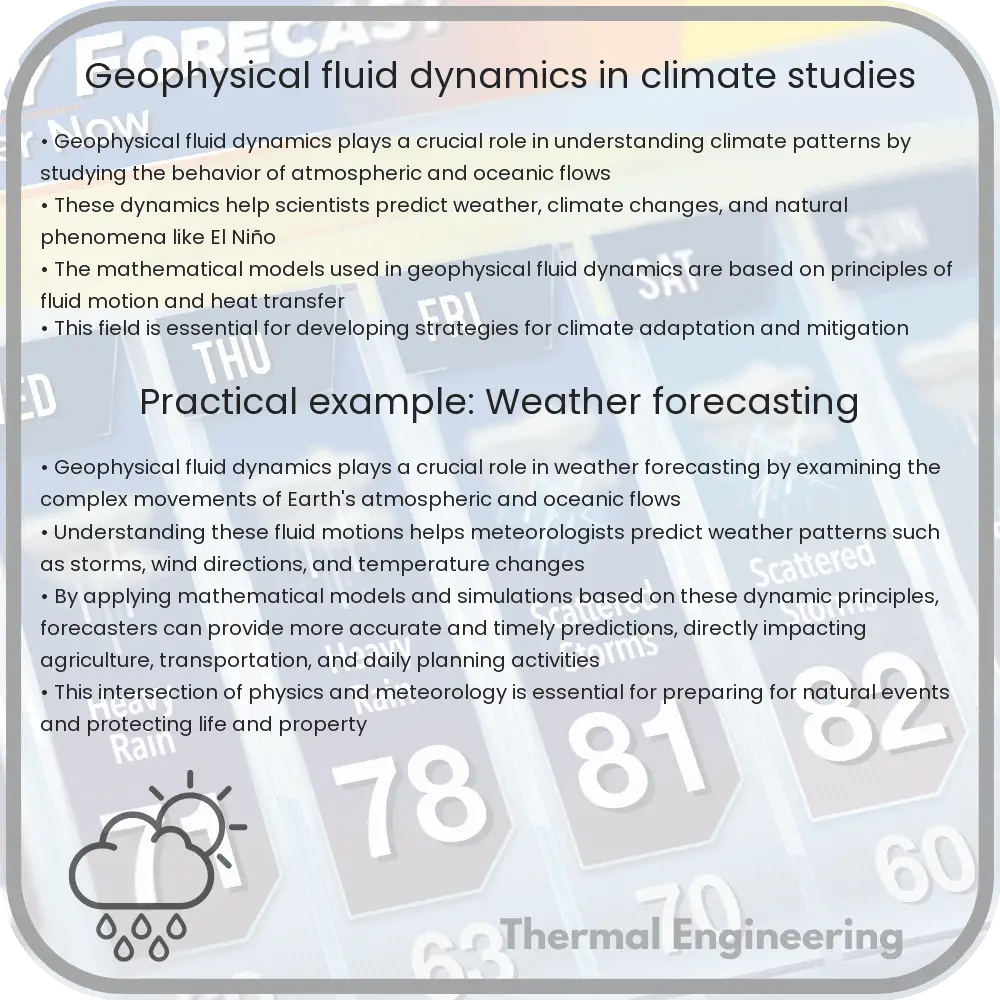Geophysical fluid dynamics explores natural fluid flows on Earth, aiding in understanding climate patterns and changes.

Understanding Geophysical Fluid Dynamics in Climate Studies
Geophysical fluid dynamics (GFD) is a fundamental branch of fluid mechanics that deals with the natural flows occurring on Earth and other celestial bodies. It encompasses the study of both atmospheric and oceanic motion driven by forces such as gravity, Coriolis effect, and thermal gradients. Importantly, this field plays a vital role in climate studies, offering insights into how these large-scale fluid flows affect weather, climate patterns, and ultimately global climate change.
The Basics of Geophysical Fluid Dynamics
The study of GFD focuses on the complex interactions between fluid flows and the forces acting on them. Some key forces include:
- Gravity: Causes fluids to flow downhill and influences oceanic and atmospheric circulations through density variations.
- Pressure gradients: Drive fluids from high to low pressure areas, crucial in shaping weather patterns and ocean currents.
- Coriolis effect: A result of Earth’s rotation, impacting the direction of fluid flows and leading to phenomena such as trade winds and the Gulf Stream.
- Solar radiation: Affects temperature, driving thermal expansions and contractions in the atmosphere and oceans, thus influencing circulation patterns.
GFD also involves the formulation and solving of the Navier-Stokes equations under the influence of these forces. These equations describe how the velocity field of fluid flows evolves in response to various forces and are expressed as:
i. Continuity equation (mass conservation):
\[\nabla \cdot \vec{v} = 0\]
ii. Momentum equation (force balance):
\[\frac{\partial \vec{v}}{\partial t} + (\vec{v} \cdot \nabla)\vec{v} = -\frac{1}{\rho}\nabla p + \nu \nabla^2 \vec{v} + \vec{f}\]
where \(\vec{v}\) represents the velocity field, \(p\) is pressure, \(\rho\) is density, \(\nu\) is viscosity, and \(\vec{f}\) includes external forces such as gravity and Coriolis force.
Application of GFD in Climate Studies
One critical application of GFD in climate studies is in the development and refinement of climate models. These models are essential for predicting future climate patterns and understanding potential impacts of climate change. GFD helps model how heat and carbon are transported in the atmosphere and oceans, influencing global temperatures and weather extremes.
Moreover, GFD is integral in studying phenomena like El Niño and La Niña, which have profound effects on global weather. The dynamics of these events, involving interactions between ocean and atmosphere, are governed by the principles of GFD.
Through satellite data and supercomputers, researchers can implement GFD to simulate flows on the global scale, improving the accuracy of weather forecasting and climate projections. Advances in computational fluid dynamics (CFD) have also enhanced the resolution and accuracy of these models, enabling more detailed and comprehensive climate analysis.
Challenges and Future Directions
Despite notable advances, there remain challenges in GFD, particularly relating to the scale and complexity of climate systems. Issues such as turbulent flows and chaotic system behavior present difficulties in accurately predicting long-term climate changes. Researchers continue to refine methods to handle these complexities, integrating data from multiple sources and utilizing increasingly powerful computational resources.
The future of GFD in climate studies will likely focus on improving multi-scale models and enhancing our understanding of feedback mechanisms between different components of the Earth system. As we continue to witness the unfolding impacts of climate change, the role of GFD will undoubtedly remain essential in devising strategies to mitigate and adapt to these changes effectively.
The intersection of GFD with advanced technology and interdisciplinary research holds the promise of yielding deeper insights into the complexities of our planet’s climate, contributing significantly to sustaining Earth’s environment for future generations.